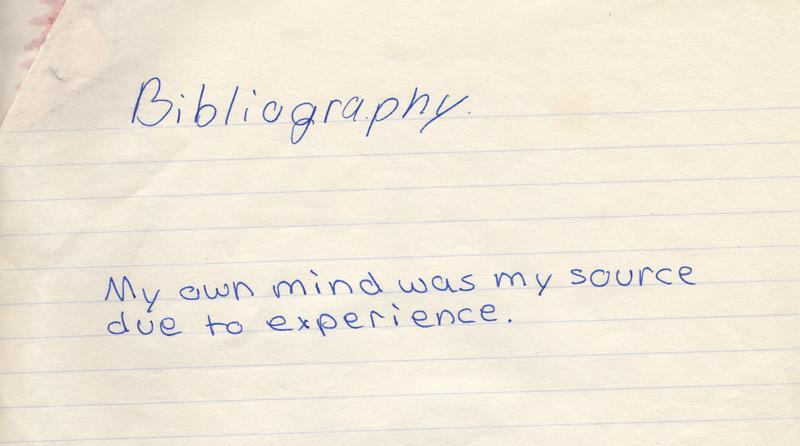Part 6: Chapter 35
Part of the research process includes keeping track of your research through a working bibliography. One way to do this is through creating an annotated bibliography, a list of all the sources you have researched, including both their full bibliographic citations and some notes on how you might want to use each resource in your work.

The Writer’s Handbook explains that to make the best use of your research time, thoroughly read each source that is clearly relevant and document all the pieces you might use from it so that you will have a good chance of not having to revisit it. But just in case, take care to bookmark the site (and additionally save it to a folder set up for your research project) so you can easily return to it later and collect the needed information.

Ideally when working on a research paper, you should keep an annotated bibliography of the sources you plan to use–include both the bibliographic information and notes on each source. Each entry should include the following elements:
-
The complete citation information (in the format the assignment requires)
-
A summary or paraphrase of the contents of the source in your words
-
The direct quotations you may end up using (with page or paragraph numbers)
-
Additional strategy notes about how you plan to use the source
For the citation, gather the following components:
-
Name of author, editor, sponsoring organization, discussion group, or list
-
Title of article or subject line of discussion
-
Title of journal or site that has published the article
-
Version number or issue number, if applicable
-
Date of publication
-
Date you accessed the site
If a source does not appear to be as relevant as you initially thought it would be, document the situation in your log and move on. Don’t try to jam it into the essay just because you spent time tracking it down. Good researchers and good writers know they’ll encounter a few dead ends and bad leads.
Adapted from “Chapter Seven” of Writers’ Handbook, 2012, used according to creative commons CC BY-NC-SA 3.0
Uses of an Annotated Bibliography
Boundless Writing explains that annotated bibliographies are useful for several reasons. If you keep one while you research, the annotated bibliography will function as a useful guide. Also, it will be easier for you to revisit sources later because you will already have notes explaining how you want to use each source. Additionally, if you find an annotated bibliography attached to one of the sources you are using, you can look at it to find other possible resources for your paper. While it’s a good idea to keep a working annotated bibliography to help you during the writing process, you may also be assigned a more formal annotated bibliography for a course, such as English 1120, which often requires one. There are a few reasons your teachers might assign these: to review your sources, to help you summarize and evaluate your sources, to help you practice formal citation and to prepare you for upper division coursework.
Constructing Your Citations
To create a more formal annotated bibliography, make sure the first part of each entry in an annotated bibliography is the source’s full citation. A description of common citation practices can be found in the next few chapters. Two commonly assigned styles of citation are APA and MLA, and you will find details on both styles of citation in this textbook.
What to Include in a Formal Annotation
A good annotation has three parts, in addition to the complete bibliographic information for the source:
- A brief summary of the source written in your own words
- A critique and evaluation of credibility, and
- An explanation of how you will use the source in your essay
Start by stating the main idea of the source. If you have space, note the specific information that you want to use from the source, such as quotations, chapters, or page numbers. Then explain if the source is credible, and note any potential bias you observe. Finally, explain how that information is useful to your own work.
You may also consider the including:
-
An explanation about the authority and/or qualifications of the author
-
The scope or main purpose of the work
-
Any detectable bias or interpretive stance
-
The intended audience and level of reading
Example Annotation
Source: Farley, John. “The Spontaneous-Generation Controversy (1700–1860): The Origin of Parasitic Worms.” Journal of the History of Biology, 5 (Spring 1972), 95–125.
-
Notes: This essay discusses the conversation about spontaneous generation that was taking place around the time that Frankenstein was written. In addition, it introduces a distinction between abiogenesis and heterogenesis. The author argues that the accounts of spontaneous generation from this time period were often based on incorrect assumptions: that the discussion was focused primarily on micro-organisms, and that spontaneous-generation theories were disproved by experiments. The author takes a scientific approach to evaluating theories of spontaneous generation, and the presentation of his argument is supported with sources. It is a reliable and credible source. The essay will be helpful in forming a picture of the early 19th-century conversation about how life is formed, as well as explaining the critical perception of spontaneous-generation theories during the 19th century.
Adapted from “Chapter 7” of Writing, 2015, used under
creative commons CC-BY-SA 4.0